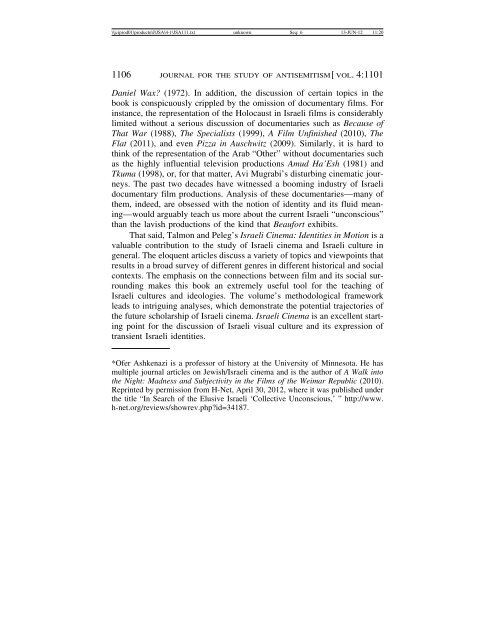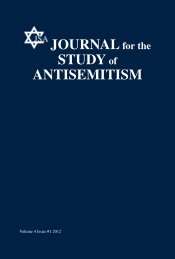Talmon and Peleg's Israeli Cinema - Journal for the Study of ...
Talmon and Peleg's Israeli Cinema - Journal for the Study of ...
Talmon and Peleg's Israeli Cinema - Journal for the Study of ...
Create successful ePaper yourself
Turn your PDF publications into a flip-book with our unique Google optimized e-Paper software.
\\jciprod01\productn\J\JSA\4-1\JSA111.txt unknown Seq: 6 13-JUN-12 11:20<br />
1106 JOURNAL FOR THE STUDY OF ANTISEMITISM[ VOL. 4:1101<br />
Daniel Wax? (1972). In addition, <strong>the</strong> discussion <strong>of</strong> certain topics in <strong>the</strong><br />
book is conspicuously crippled by <strong>the</strong> omission <strong>of</strong> documentary films. For<br />
instance, <strong>the</strong> representation <strong>of</strong> <strong>the</strong> Holocaust in <strong>Israeli</strong> films is considerably<br />
limited without a serious discussion <strong>of</strong> documentaries such as Because <strong>of</strong><br />
That War (1988), The Specialists (1999), A Film Unfinished (2010), The<br />
Flat (2011), <strong>and</strong> even Pizza in Auschwitz (2009). Similarly, it is hard to<br />
think <strong>of</strong> <strong>the</strong> representation <strong>of</strong> <strong>the</strong> Arab “O<strong>the</strong>r” without documentaries such<br />
as <strong>the</strong> highly influential television productions Amud Ha’Esh (1981) <strong>and</strong><br />
Tkuma (1998), or, <strong>for</strong> that matter, Avi Mugrabi’s disturbing cinematic journeys.<br />
The past two decades have witnessed a booming industry <strong>of</strong> <strong>Israeli</strong><br />
documentary film productions. Analysis <strong>of</strong> <strong>the</strong>se documentaries—many <strong>of</strong><br />
<strong>the</strong>m, indeed, are obsessed with <strong>the</strong> notion <strong>of</strong> identity <strong>and</strong> its fluid meaning—would<br />
arguably teach us more about <strong>the</strong> current <strong>Israeli</strong> “unconscious”<br />
than <strong>the</strong> lavish productions <strong>of</strong> <strong>the</strong> kind that Beau<strong>for</strong>t exhibits.<br />
That said, <strong>Talmon</strong> <strong>and</strong> Peleg’s <strong>Israeli</strong> <strong>Cinema</strong>: Identities in Motion is a<br />
valuable contribution to <strong>the</strong> study <strong>of</strong> <strong>Israeli</strong> cinema <strong>and</strong> <strong>Israeli</strong> culture in<br />
general. The eloquent articles discuss a variety <strong>of</strong> topics <strong>and</strong> viewpoints that<br />
results in a broad survey <strong>of</strong> different genres in different historical <strong>and</strong> social<br />
contexts. The emphasis on <strong>the</strong> connections between film <strong>and</strong> its social surrounding<br />
makes this book an extremely useful tool <strong>for</strong> <strong>the</strong> teaching <strong>of</strong><br />
<strong>Israeli</strong> cultures <strong>and</strong> ideologies. The volume’s methodological framework<br />
leads to intriguing analyses, which demonstrate <strong>the</strong> potential trajectories <strong>of</strong><br />
<strong>the</strong> future scholarship <strong>of</strong> <strong>Israeli</strong> cinema. <strong>Israeli</strong> <strong>Cinema</strong> is an excellent starting<br />
point <strong>for</strong> <strong>the</strong> discussion <strong>of</strong> <strong>Israeli</strong> visual culture <strong>and</strong> its expression <strong>of</strong><br />
transient <strong>Israeli</strong> identities.<br />
*Ofer Ashkenazi is a pr<strong>of</strong>essor <strong>of</strong> history at <strong>the</strong> University <strong>of</strong> Minnesota. He has<br />
multiple journal articles on Jewish/<strong>Israeli</strong> cinema <strong>and</strong> is <strong>the</strong> author <strong>of</strong> A Walk into<br />
<strong>the</strong> Night: Madness <strong>and</strong> Subjectivity in <strong>the</strong> Films <strong>of</strong> <strong>the</strong> Weimar Republic (2010).<br />
Reprinted by permission from H-Net, April 30, 2012, where it was published under<br />
<strong>the</strong> title “In Search <strong>of</strong> <strong>the</strong> Elusive <strong>Israeli</strong> ‘Collective Unconscious,’ ” http://www.<br />
h-net.org/reviews/showrev.php?id=34187.














